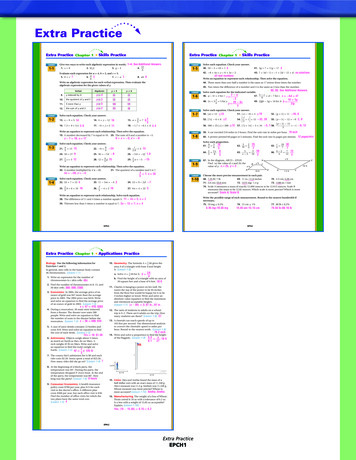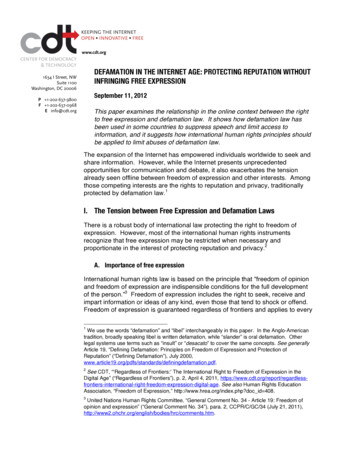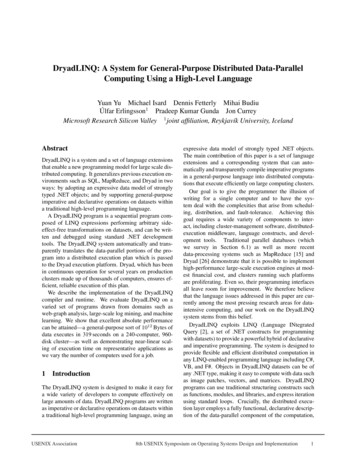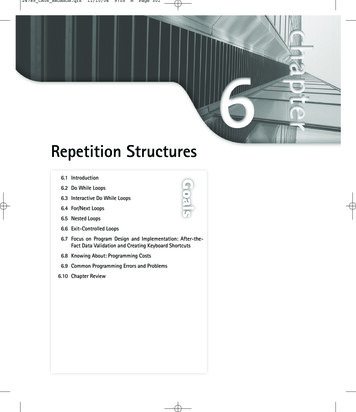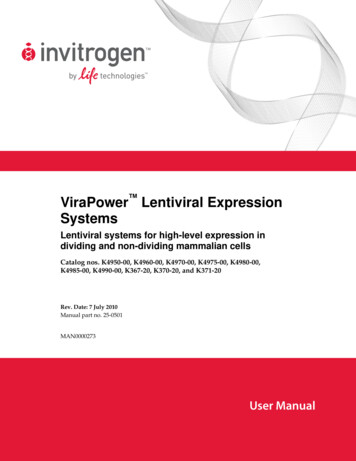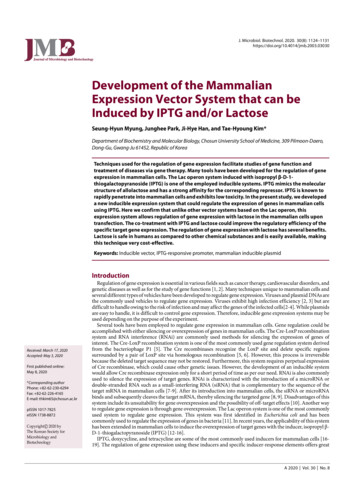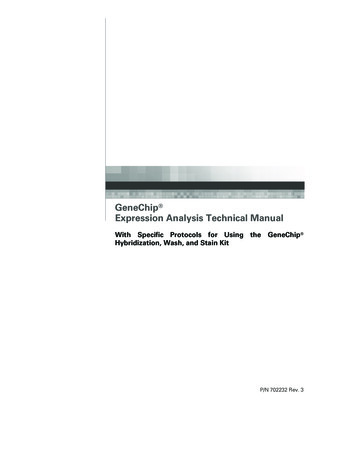
Transcription
GeneChip Expression Analysis Technical ManualWith Specific Protocols for Using the GeneChip Hybridization, Wash, and Stain KitP/N 702232 Rev. 3
For research use only. Not for use in diagnostic procedures.TrademarksAffymetrix , GeneChip ,, HuSNP , GenFlex , Flying Objective ,CustomExpress , CustomSeq , NetAffx , Tools To Take You As Far As Your Vision ,The Way Ahead , Powered by Affymetrix , and GeneChip-compatible , aretrademarks of Affymetrix, Inc.GeneArray is a registered U.S. trademark of Agilent Technologies, Inc.All other trademarks are the property of their respective owners.Limited LicenseSubject to the Affymetrix terms and conditions that govern your use of Affymetrixproducts, Affymetrix grants you a non-exclusive, non-transferable, non-sublicensablelicense to use this Affymetrix product only in accordance with the manual and writteninstructions provided by Affymetrix. You understand and agree that except asexpressly set forth in the Affymetrix terms and conditions, that no right or license toany patent or other intellectual property owned or licensable by Affymetrix isconveyed or implied by this Affymetrix product. In particular, no right or license isconveyed or implied to use this Affymetrix product in combination with a product notprovided, licensed or specifically recommended by Affymetrix for such use.PatentsArrays: Products may be covered by one or more of the following patents: U.S.Patent Nos. 5,445,934; 5,744,305; 5,945,334; 6,140,044; 6,261,776; 6,291,183;6,346,413; 6,399,365; 6,420,169; 6,551,817; 6,610,482; 6,733,977; 6,955,915 andD430,024 and other U.S. or foreign patents. Products are manufactured and soldunder license from OGT under 5,700,637 and 6,054,270.Software: Software products may be covered by one or more of the followingpatents: U.S. Patent Nos. 5,733,729; 5,795,716; 5,974,164; 6,066,454; 6,090,555;6,185,561; 6,188,783; 6,223,127; 6,228,593; 6,229,911; 6,242,180; 6,308,170; 6,361,937;6,420,108; 6,484,183; 6,505,125; 6510,391; 6,532,462; 6,546,340; 6,687,692; 6,607,887;7,062,092 and other U.S. or foreign patents.Fluidics Station: Products may be covered by U.S. Patent Nos. 6,114,122; 6,287,850;6,391,623; 6,422,249; and other U.S. or foreign patents.Scanners: Products may be covered by one or more of the following patents: U.S.Patent Nos. 5,578,832; 5,631,734; 5,834,758; 5,936,324; 5,981,956; 6,025,601;6,141,096; 6,171,793; 6,185,030; 6,201,639; 6,207,960; 6,218,803; 6,225,625; 6,252,236;6,335,824; 6,403,320; 6,407,858; 6,472,671; 6,490,533; 6,650,411; 6,643,015; 6,813,567;and other U.S. or foreign patents.Autoloaders: Products may be covered by one or more of the following patents: U.S.Patent Nos. 6,511,277; 6,604,902; 6,705,754; 7,108,472; and other U.S. or foreignpatents.Hybridization Oven: Products may be covered by one or more of the followingpatents: U.S. Patent Nos. 6,050,719; 6,386,749; 6,705,754; and other U.S. or foreignpatents.Copyright 2005-2009 Affymetrix Inc. All rights reserved.
iContentsCHAPTER 1CHAPTER 2Overview1CHAPTER CONTENTS3INTRODUCTION AND OBJECTIVES4EXPLANATION OF GENECHIP PROBE ARRAYS4GENECHIP EXPRESSION ANALYSIS OVERVIEWStep 1: Target PreparationStep 2: Target HybridizationStep 3: Fluidics Station SetupStep 4: Probe Array Washing and StainingStep 5: Probe Array ScanStep 6: Data Analysis5566667PRECAUTIONS7TERMINOLOGY8INTERFERING ryotic Target Preparation11CHAPTER CONTENTS13INTRODUCTION14REAGENTS AND MATERIALS REQUIRED17
iiGeneChip Expression Analysis Technical ManualTOTAL RNA AND mRNA ISOLATION FOR ONE-CYCLE TARGETLABELING ASSAYIsolation of RNA from YeastIsolation of RNA from ArabidopsisIsolation of RNA from Mammalian Cells or TissuesPrecipitation of RNAQuantification of RNA202021212223TOTAL RNA ISOLATION FOR TWO-CYCLE TARGETLABELING ASSAY24ONE-CYCLE cDNA SYNTHESISStep 1: Preparation of Poly-A RNA Controls for One-CyclecDNA Synthesis (Spike-in Controls)Step 2: First-Strand cDNA SynthesisStep 3: Second-Strand cDNA Synthesis25TWO-CYCLE cDNA SYNTHESISStep 1: Preparation of Poly-A RNA Controls for Two-CyclecDNA Synthesis (Spike-in Controls)Step 2: First-Cycle, First-Strand cDNA SynthesisStep 3: First-Cycle, Second-Strand cDNA SynthesisStep 4: First-Cycle, IVT Amplification of cRNAStep 5: First-Cycle, Cleanup of cRNAStep 6: Second-Cycle, First-Strand cDNA SynthesisStep 7: Second-Cycle, Second-Strand cDNA Synthesis3333363840424446CLEANUP OF DOUBLE-STRANDED cDNA FOR BOTH THEONE-CYCLE AND TWO-CYCLE TARGET LABELING ASSAYS48SYNTHESIS OF BIOTIN-LABELED cRNA FOR BOTH THEONE-CYCLE AND TWO-CYCLE TARGET LABELING ASSAYS50252831CLEANUP AND QUANTIFICATION OF BIOTIN-LABELED cRNAStep 1: Cleanup of Biotin-Labeled cRNAStep 2: Quantification of the cRNAStep 3: Checking Unfragmented Samples by GelElectrophoresis52525455FRAGMENTING THE cRNA FOR TARGET PREPARATION57
contentsCHAPTER 3CHAPTER 4CHAPTER 5Eukaryotic Target Hybridizationiii59CHAPTER CONTENTS61REAGENTS AND MATERIALS REQUIRED62EUKARYOTIC TARGET HYBRIDIZATION63Prokaryotic Target Preparation67CHAPTER CONTENTS69REAGENTS AND MATERIALS REQUIRED71REAGENT PREPARATION72TOTAL RNA ISOLATION72cDNA SYNTHESISStep 1: Preparation of Poly-A RNA ControlsStep 2: cDNA SynthesisStep 3: Removal of RNAStep 4: Purification and Quantitation of cDNA7474767778cDNA FRAGMENTATION79TERMINAL LABELING80Prokaryotic Target Hybridization83CHAPTER CONTENTS85REAGENTS AND MATERIALS REQUIRED85PROKARYOTIC TARGET HYBRIDIZATION86
ivCHAPTER 6APPENDIX AGeneChip Expression Analysis Technical ManualProkaryotic Arrays:Washing, Staining and Scanning89CHAPTER CONTENTS91REAGENTS AND MATERIALS REQUIRED92EXPERIMENT AND FLUIDICS STATION SETUPStep 1: Defining File LocationsStep 2: Entering Experiment InformationStep 3: Preparing the Fluidics Station94949596PROBE ARRAY WASH AND STAINPreparing the Stain ReagentsUsing the Fluidics Station 450/250Using the Fluidics Station 400979898102PROBE ARRAY SCANHandling the GeneChip Probe ArrayScanning the Probe Array107107108SHUTTING DOWN THE FLUIDICS STATION109CUSTOMIZING THE PROTOCOL111Alternative Protocols for One-CyclecDNA SynthesisREAGENTS AND MATERIALS REQUIRED113115ALTERNATIVE PROTOCOL FOR ONE-CYCLE cDNA SYNTHESISFROM TOTAL RNA116Step 1: First-Strand cDNA Synthesis116Step 2: Second-Strand cDNA Synthesis118ALTERNATIVE PROTOCOL FOR ONE-CYCLE cDNA SYNTHESISFROM PURIFIED POLY-A mRNA119Step 1: First-Strand cDNA Synthesis119Step 2: Second-Strand cDNA Synthesis121
contentsAPPENDIX BAPPENDIX CAPPENDIX DAlternative Protocol forEukaryotic Target Hybridizationv123INTRODUCTION AND OBJECTIVES126REAGENTS AND MATERIALS REQUIRED127REAGENT PREPARATION128EUKARYOTIC TARGET HYBRIDIZATION129Alternative Protocol forProkaryotic Target Hybridization133INTRODUCTION AND OBJECTIVES135REAGENTS AND MATERIALS REQUIRED136REAGENT PREPARATION137PROKARYOTIC TARGET HYBRIDIZATION138Alternative Protocol for Prokaryotic Arrays:Washing, Staining and Scanning141INTRODUCTION AND OBJECTIVES144REAGENTS AND MATERIALS REQUIRED145REAGENT PREPARATION146EXPERIMENT AND FLUIDICS STATION SETUPStep 1: Defining File LocationsStep 2: Entering Experiment InformationStep 3: Preparing the Fluidics Station147147148149PROBE ARRAY WASH AND STAINUsing the Fluidics Station 450/250Using the Fluidics Station 400150155157
viAPPENDIX EAPPENDIX GGeneChip Expression Analysis Technical ManualPROBE ARRAY SCANHandling the GeneChip Probe ArrayScanning the Probe Array159159160SHUTTING DOWN THE FLUIDICS STATION161CUSTOMIZING THE PROTOCOL162List of Controls on GeneChip Probe Arrays 165CONTROL GENES ON GENECHIP EUKARYOTIC PROBEARRAYS167CONTROL GENES ON GENECHIP PROKARYOTIC PROBEARRAYS168Contact Information169AFFYMETRIX TECHNICAL SUPPORT171SUPPLIER CONTACT INFORMATION172
Chapter1Overview
Chapter1
3Chapter ContentsIntroduction and Objectives . . . . . . .Explanation of GeneChip Probe Arrays .GeneChip Expression Analysis OverviewPrecautions . . . . . . . . . . . . . . . .Terminology . . . . . . . . . . . . . . .Interfering Conditions . . . . . . . . . .Instruments . . . . . . . . . . . . . . . .References. . . . . . . . . . . . . . . . .Limitations . . . . . . . . . . . . . . . .This Chapter Contains: An overview of GeneChip Expression Analysis. A summary of the procedures covered in the remainder of themanual.4.4.5.7.8.8.8.8.9
4GeneChip Expression Analysis Technical ManualIntroduction and ObjectivesWelcome to the Affymetrix GeneChip Expression Analysis TechnicalManual. This manual is a technical guide for using GeneChipexpression analysis probe arrays. All protocols included in this manualhave been used successfully by scientists at Affymetrix, or have beenrecommended by our collaborators during the development ofparticular products. The field of mRNA gene expression monitoringis rapidly evolving and periodic technical updates to this manual willreflect the newest protocols and information for using GeneChip probearrays. This manual applies to all GeneChip 3’ eukaryotic arrays incartridge format and GeneChip prokaryotic arrays in cartridge format.As an Affymetrix GeneChip user, your feedback is welcome. Pleasecontact our technical support team with any input on how we canimprove this resource.Explanation of GeneChip Probe ArraysGeneChip probe arrays are manufactured using technology thatcombines photolithography and combinatorial chemistry.1,2 Up to1.3 million different oligonucleotide probes are synthesized on eacharray. Each oligonucleotide is located in a specific area on the arraycalled a probe cell. Each probe cell contains hundreds of thousands tomillions of copies of a given oligonucleotide.Probe arrays are manufactured in a series of cycles. Initially, a glasssubstrate is coated with linkers containing photolabile protectinggroups. Then, a mask is applied that exposes selected portions of theprobe array to ultraviolet light. Illumination removes the photolabileprotecting groups enabling selective nucleoside phosphoramiditeaddition only at the previously exposed sites. Next, a different mask isapplied and the cycle of illumination and chemical coupling isperformed again. By repeating this cycle, a specific set ofoligonucleotide probes is synthesized with each probe type in a knownlocation. The completed probe arrays are packaged into cartridges.During the laboratory procedure described in this manual, biotinlabeled RNA or DNA fragments referred to as the “target” arehybridized to the probe array. The hybridized probe array is stainedwith streptavidin phycoerythrin conjugate and scanned by theGeneArray Scanner or the GeneChip Scanner 3000. The amount of1Sambrook, J., Fritsch, E.F., Maniatis, T. Molecular Cloning: A Laboratory Manual, v.1 Cold Spring Harbor Laboratory Press, Cold Spring Harbor, NY p 21-52 (1989).2See www.affymetrix.com for current GeneChip technology references.
chapter 1 Overview5light emitted at 570 nm is proportional to the bound target at eachlocation on the probe array.GeneChip Expression Analysis OverviewThe following major steps outline GeneChip expression analysis:1.Target Preparation2. Target Hybridization3. Fluidics Station Setup4.Probe Array Washing and Staining5. Probe Array Scan6. Data AnalysisDue to the differences in the RNA species between eukaryotic andprokaryotic organisms, different target labeling protocols have beenoptimized. Chapters 2 through 6 provide detailed protocols for targetpreparation, hybridization, array washing, and staining for eukaryoticand prokaryotic arrays, respectively. Please refer to the sections in thismanual for detailed protocols appropriate for your arrays.STEP 1: TARGET PREPARATIONThis manual describes procedures using GeneChip reagent kits forpreparing biotinylated target from purified eukaryotic andprokaryotic RNA samples suitable for hybridization to GeneChipexpression probe arrays. For more information on these procedures,please contact Affymetrix Technical Support at 1-888-DNA-CHIP, 44 (0)1628 552550 in Europe, or 81-(0)3-5730-8200 in Japan.For eukaryotic samples, using protocols referenced in Chapter 2,double-stranded cDNA is synthesized from total RNA or purifiedpoly-A messenger RNA isolated from tissue or cells. An in vitrotranscription (IVT) reaction is then done to produce biotin-labeledcRNA from the cDNA. The cRNA is fragmented beforehybridization.For prokaryotic samples, Chapter 4 describes a detailed protocol toisolate total RNA followed by reverse transcription with randomhexamers to produce cDNA. After fragmentation by DNase I, thecDNA is end-labeled with biotin by terminal transferase.
6GeneChip Expression Analysis Technical ManualSTEP 2: TARGET HYBRIDIZATIONA hybridization cocktail is prepared, including the fragmented target,and probe array controls. It is then hybridized to the probe arrayduring a 16-hour incubation. The hybridization process is described inthe respective sections for the different probe array types. Refer toChapter 3 for hybridization of eukaryotic samples, and Chapter 5 forprokaryotic samples.STEP 3: FLUIDICS STATION SETUPSpecific experimental information is defined using Affymetrix Microarray Suite or GeneChip Operating Software (GCOS) on a PCcompatible workstation. The probe array type, sample description,and comments are entered and saved with a unique experiment name.The fluidics station is then prepared for use by priming with theappropriate buffers. Refer to the GeneChip Expression Wash, Stain andScan User Manual, P/N 702731 for information on fluidics stationsetup for eukaryotic samples, and Chapter 6 for prokaryotic samples.For more information on the fluidics station, refer to the GeneChip Fluidics Station User’s Guide.STEP 4: PROBE ARRAY WASHING AND STAININGImmediately following hybridization, the probe array undergoes anautomated washing and staining protocol on the fluidics station. TheGeneChip Expression Wash, Stain and Scan User Manual, P/N 702731provides information for eukaryotic samples, and Chapter 6 providesinformation for prokaryotic samples.STEP 5: PROBE ARRAY SCANOnce the probe array has been hybridized, washed, and stained, it isscanned. Each workstation running Affymetrix Microarray Suite orGCOS can control one scanner. The software defines the probe cellsand computes an intensity for each cell.Each complete probe array image is stored in a separate data fileidentified by the experiment name and is saved with a data image file(.dat) extension.Review the scanner user’s manual for safety precautions and for moreinformation on using the scanner.
chapter 1 Overview7STEP 6: DATA ANALYSISThe .dat image is analyzed for probe intensities; results are reported intabular and graphical formats. Information on data analysis isprovided in the enclosed GeneChip Expression Analysis: Data AnalysisFundamentals booklet (P/N 701190).Precautions1.FOR RESEARCH USE ONLY; NOT FOR USE INDIAGNOSTIC PROCEDURES.2.Avoid microbial contamination, which may cause erroneousresults.All biological specimens and materials with which they come intocontact should be handled as if capable of transmitting infectionand disposed of with proper precautions in accordance withfederal, state, and local regulations. This includes adherence to theOSHA Bloodborne Pathogens Standard (29 CFR 1910.1030) forblood-derived and other samples governed by this act. Never pipetby mouth. Avoid specimen contact with skin and mucousmembranes.3.Exercise standard precautions when obtaining, handling, anddisposing of potentially carcinogenic reagents.4. Exercise care to avoid cross contamination of samples during allsteps of this procedure, as this may lead to erroneous results.5. Use powder-free gloves whenever possible to minimizeintroduction of powder particles into sample or probe arraycartridges.
8GeneChip Expression Analysis Technical ManualTerminologyProbesThe oligonucleotides on the surface of the probearrays are called probes because they probe, orinterrogate, the sample.TargetThe target is the labeled nucleic acid that is beinginterrogated. It is hybridized to the probes on thearray.Probe CellSpecific areas on the probe array that containoligonucleotides of a specific sequence.Interfering ConditionsWear powder-free gloves throughout procedure. Take steps tominimize the introduction of exogenous nucleases. Water used inthe protocols below is molecular biology grade (nuclease free).Proper storage and handling of reagents and samples is essential forrobust performance.All laboratory equipment used to prepare the target during thisprocedure should be calibrated and carefully maintained to ensureaccuracy, as incorrect measurement of reagents may affect the outcomeof the procedure.InstrumentsThe GeneChip Expression Analysis Technical Manual is designed for usein a system consisting of a Fluidics Station, a Hybridization Oven 640,and a Scanner.References1.Sambrook, J., Fritsch, E.F., Maniatis, T. Molecular Cloning: ALaboratory Manual, v.1 Cold Spring Harbor Laboratory Press, ColdSpring Harbor, NY p 21-52 (1989).2. See www.affymetrix.com for current GeneChip technologyreferences.
chapter 1 Overview9Limitations The results of the assay are dependent upon the quality of the inputRNA, subsequent proper handling of nucleic acids and otherreagents. The results should be evaluated by a qualified individual.Do not store enzymes in a frost-free freezer.
10GeneChip Expression Analysis Technical Manual
Chapter2Eukaryotic Target Preparation
Chapter2
13Chapter ContentsIntroduction . . . . . . . . . . . . . . . . . . . . . . . .Reagents and Materials Required . . . . . . . . . . . . . .Total RNA and mRNA Isolation for One-CycleTarget Labeling Assay. . . . . . . . . . . . . . . . . . . .Isolation of RNA from Yeast . . . . . . . . . . . . . . .Isolation of RNA from Arabidopsis . . . . . . . . . . . .Isolation of RNA from Mammalian Cells or Tissues . . .Precipitation of RNA . . . . . . . . . . . . . . . . . . .Quantification of RNA . . . . . . . . . . . . . . . . . .Total RNA Isolation for Two-Cycle Target Labeling Assay .One-Cycle cDNA Synthesis . . . . . . . . . . . . . . . . .Step 1: Preparation of Poly-A RNA Controls forOne-Cycle cDNA Synthesis (Spike-in Controls). . . . . .Step 2: First-Strand cDNA Synthesis . . . . . . . . . . .Step 3: Second-Strand cDNA Synthesis . . . . . . . . . .Two-Cycle cDNA Synthesis. . . . . . . . . . . . . . . . .Step 1: Preparation of Poly-A RNA Controls forTwo-Cycle cDNA Synthesis (Spike-in Controls) . . . . .Step 2: First-Cycle, First-Strand cDNA Synthesis. . . . .Step 3: First-Cycle, Second-Strand cDNA Synthesis . . .Step 4: First-Cycle, IVT Amplification of cRNA . . . . .Step 5: First-Cycle, Cleanup of cRNA . . . . . . . . . .Step 6: Second-Cycle, First-Strand cDNA Synthesis . . .Step 7: Second-Cycle, Second-Strand cDNA Synthesis . .Cleanup of Double-Stranded cDNA for Both theOne-Cycle and Two-Cycle Target Labeling Assays . . . . .Synthesis of Biotin-Labeled cRNA for Both theOne-Cycle and Two-Cycle Target Labeling Assays . . . . . . . 14. . . 17. 20. 20. 21. 21. 22. 23. 24. 25. 25. 28. 31. 33. 33. 36. 38. 40. 42. 44. 46. . . 48. . . 50
14GeneChip Expression Analysis Technical ManualCleanup and Quantification of Biotin-Labeled cRNA . . . . . . . 52Step 1: Cleanup of Biotin-Labeled cRNA . . . . . . . . . . . . 52Step 2: Quantification of the cRNA . . . . . . . . . . . . . . 54Step 3: Checking Unfragmented Samples by Gel Electrophoresis55Fragmenting the cRNA for Target Preparation . . . . . . . . . . 57This Chapter Contains: Complete One-Cycle Target Labeling Assay with 1 to 15 μg of totalRNA or 0.2 to 2 μg of poly-A mRNA Complete Two-Cycle Target Labeling Assay with 10 to 100 ng oftotal RNAIntroductionThis chapter describes the assay procedures recommended foreukaryotic target labeling in expression analysis using GeneChip brand probe arrays. Following the protocols and using high-qualitystarting materials, a sufficient amount of biotin-labeled cRNA targetcan be obtained for hybridization to at least two arrays in parallel. Thereagents and protocols have been developed and optimized specificallyfor use with the GeneChip system.Depending on the amount of starting material, two procedures aredescribed in detail in this manual. Use the following table to select themost appropriate labeling protocol for your samples:Table 2.1Total RNA asStarting Material1 µg – 15 µg10 ng – 100 ngmRNA asStarting MaterialProtocol0.2 µg – 2 µgOne-Cycle Target LabelingN/ATwo-Cycle Target LabelingThe One-Cycle Eukaryotic Target Labeling Assay experimentaloutline is represented in Figure 2.1. Total RNA (1 μg to 15 μg) ormRNA (0.2 μg to 2 μg) is first reverse transcribed using a T7Oligo(dT) Promoter Primer in the first-strand cDNA synthesisreaction. Following RNase H-mediated second-strand cDNAsynthesis, the double-stranded cDNA is purified and serves as a
chapter 2 Eukaryotic Target Preparation15template in the subsequent in vitro transcription (IVT) reaction. TheIVT reaction is carried out in the presence of T7 RNA Polymerase anda biotinylated nucleotide analog/ribonucleotide mix forcomplementary RNA (cRNA) amplification and biotin labeling. Thebiotinylated cRNA targets are then cleaned up, fragmented, andhybridized to GeneChip expression arrays.For smaller amounts of starting total RNA, in the range of 10 ng to100 ng, an additional cycle of cDNA synthesis and IVT amplificationis required to obtain sufficient amounts of labeled cRNA target foranalysis with arrays. The Two-Cycle Eukaryotic Target Labeling Assayexperimental outline is also represented in Figure 2.1. After cDNAsynthesis in the first cycle, an unlabeled ribonucleotide mix is used inthe first cycle of IVT amplification. The unlabeled cRNA is thenreverse transcribed in the first-strand cDNA synthesis step of thesecond cycle using random primers. Subsequently, the T7-Oligo(dT)Promoter Primer is used in the second-strand cDNA synthesis togenerate double-stranded cDNA template containing T7 promotersequences. The resulting double-stranded cDNA is then amplified andlabeled using a biotinylated nucleotide analog/ribonucleotide mix inthe second IVT reaction. The labeled cRNA is then cleaned up,fragmented, and hybridized to GeneChip expression arrays.
16GeneChip Expression Analysis Technical ManualOne-Cycle Target LabelingTwo-Cycle Target Labeling(for 1-15 µg total RNA or 0.2-2 µg mRNA)(for 10-100 ng total RNA)ApproximateExperiment TimeTotal RNA Sample5'ProductsUsedPoly-A RNAControl KitApproximateExperiment TimeTotal RNA Sample5'3'AAAAA 3'TTTTT –AAAAA –TTTTT –3'5'Un-labeledRibonucleotides1st cycle, In vitrotranscription3'2 hoursTwo-CyclecDNASynthesisKit2 hours5'3'1.5 hours2nd strandcDNA synthesis5'2ndcycle,strandcDNA synthesisT7 – Oligo(dT) PrimerOne-CyclecDNASynthesisKitPoly-A RNAControl KitT7 – Oligo(dT) Primer1.5 hours3' TTTTT –5'1st cycle, 1st strandcDNA synthesis1st1st strandcDNA synthesisAAAAA 3'Poly-A RNA ControlsPoly-A RNAControl additionPoly-A RNA ControlsPoly-A RNAControl additionOvernightUUUUU 5'1st cycle, Cleanup ofantisense RNA (cRNA)0.5 hoursRandomPrimers2nd cycle, 1st strandcDNA synthesis5'3'T7 – Oligo(dT) Primer2.5 hours3' TTTTT –5'AAAAA –TTTTT –5'3'3'5'ProductsUsedCleanup of double-stranded cDNABiotin labeling of antisense cRNAIVTLabeling Kit3'SampleCleanupModule0.5 hoursBiotinylated4 hours –Ribonucleotide overnightAnalogU*U U*U U 5 'Cleanup of biotinylated cRNA0.5 hoursFragmentation1 hourHybridization controlsHybridizationControl Kit16 hoursHybridizationHybridizationWash andStain nylated anti-streptavidinantibody1.5 hoursScanningLegend 12 minutesRNADNAT7 promoterBiotinU*— PseudouridineFigure 2.1GeneChip Eukaryotic Labeling Assays for Expression AnalysisIVT cRNACleanupKit1.5 hoursAAAAA 3'UUUUU 5'2nd cycle, 2nd strandcDNA DNASynthesisKit
chapter 2 Eukaryotic Target Preparation17Reagents and Materials RequiredThe following reagents and materials are recommendations and havebeen tested and evaluated by Affymetrix scientists. Information andpart numbers listed are based on U.S. catalog information. Forsupplier information, please refer to the Supplier Reference List inAppendix G of this manual.Do not store enzymes in a frost-free freezer.Total RNA Isolation TRIzol Reagent: Invitrogen Life Technologies, P/N 15596-018, orQIAzol Lysis Reagent: QIAGEN, P/N 79306 RNeasy Mini Kit: QIAGEN, P/N 74104Poly-A mRNA Isolation Oligotex Direct mRNA Kit (isolation of mRNA from whole cells):QIAGEN, P/N 72012, 72022, or 72041 Oligotex mRNA Kit (isolation of mRNA from total RNA):QIAGEN, P/N 70022, 70042, or 70061 QIAshredder: QIAGEN, P/N 79654 (Required only for use withQIAGEN Oligotex Direct Kit) DEPC-Treated Water: Ambion, P/N 9920
18GeneChip Expression Analysis Technical ManualOne-Cycle Target Labeling GeneChip One-Cycle Target Labeling and Control Reagents:Affymetrix, P/N 900493. A convenient package containing allrequired labeling and control reagents to perform 30 one-cyclelabeling reactions. Each of these components may be orderedindividually (described below) as well as in this complete kit.Contains:- 1 GeneChip IVT Labeling Kit (Affymetrix, P/N 900449)- 1 GeneChip One-Cycle cDNA Synthesis Kit (Affymetrix,P/N 900431)- 1 GeneChip Sample Cleanup Module (Affymetrix, P/N 900371)- 1 GeneChip Poly-A RNA Control Kit (Affymetrix,P/N 900433)- 1 GeneChip Hybridization Control Kit (Affymetrix, P/N900454)Two-Cycle Target Labeling GeneChip Two-Cycle Target Labeling and Control Reagents:Affymetrix, P/N 900494. A convenient package containingrequired labeling and control reagents to perform 30 two-cyclelabeling reactions. Each of these components may be orderedindividually (described below) as well as in this complete kit.Contains:- 1 GeneChip IVT Labeling Kit (Affymetrix, P/N 900449)- 1 GeneChip Two-Cycle cDNA Synthesis Kit (Affymetrix,P/N 900432)- 1 GeneChip Sample Cleanup Module (Affymetrix, P/N 900371)- 1 GeneChip IVT cRNA Cleanup Kit (Affymetrix, 900547)- 1 GeneChip Poly-A RNA Control Kit (Affymetrix,P/N 900433)- 1 GeneChip Hybridization Control Kit (Affymetrix, P/N900454) MEGAscript High Yield Transcription Kit: Ambion Inc,P/N 1334 Purchased separately from Ambion, Inc. (2 kits requiredto complete 30 reactions)
chapter 2 Eukaryotic Target Preparation19Miscellaneous Reagents 10X TBE: Cambrex, P/N 50843 Absolute ethanol (stored at –20 C for RNA precipitation; storeethanol at room temperature for use with the GeneChip SampleCleanup Module and IVT cRNA Kit) 80% ethanol (stored at –20 C for RNA precipitation; store ethanolat room temperature for use with the GeneChip Sample CleanupModule) SYBR Green II: Cambrex, P/N 50523; or Molecular Probes,P/N S7586 (optional) Pellet Paint: Novagen, P/N 69049-3 (optional) Glycogen: Ambion, P/N 9510 (optional) 3M Sodium Acetate (NaOAc): Sigma-Aldrich, P/N S7899 Ethidium Bromide: Sigma-Aldrich, P/N E8751 1N NaOH 1N HClMiscellaneous Supplies Sterile, RNase-free, microcentrifuge vials, 1.5 mL: USA Scientific,P/N 1415-2600 (or equivalent) Micropipettors, (P-2, P-20, P-200, P-1000): Rainin Pipetman orequivalent Sterile-barrier, RNase-free pipette tips (Tips must be pointed, notrounded, for efficient use with the probe arrays) Beveled pipette tipsmay cause damage to the array septa and cause leakage. Mini agarose gel electrophoresis unit with appropriate buffers UV spectrophotometer Bioanalyzer Non-stick RNase-free microfuge tubes, 0.5 mL and 1.5 mL:Ambion, P/N12350 and P/N 12450, respectively
20GeneChip Expression Analysis Technical ManualTotal RNA and mRNA Isolation forOne-Cycle Target Labeling AssayProtocols are provided for preparing labeled cRNA from either totalRNA or purified poly-A mRNA. It was found that results obtainedfrom samples prepared by both of these methods are similar, but notidentical. Therefore, to get the best results, it is suggested to onlycompare samples prepared using the same type of RNA material.Please review precautions and interfering conditions in Chapter 1.The quality of the RNA is essential to the overall success of theanalysis. Since the most appropriate protocol for the isolation ofRNA can be source dependent, we recommend using a protocolthat has been established for the tissues or cells being used. In theabsence of an established protocol, using one of the commerciallyavailable kits designed for RNA isolation is suggested.When using a commercial kit, follow the manufacturer’s instructionsfor RNA isolation.ISOLATION OF RNA FROM YEASTTotal RNAGood-quality total RNA has been isolated successfully from yeast cellsusing a hot phenol protocol described by Schmitt, et al. Nucl Acids Res18:3091-3092 (1990).Poly-A mRNAAffymetrix recommends first purifying total RNA from yeast cellsbefore isolating poly-A mRNA from total RNA. Good-qualitymRNA has been successfully isolated from total RNA usingQIAGEN’s Oligotex mRNA Kit. A single round of poly-A mRNAselection provides mRNA of sufficient purity and yield to use as atemplate for cDNA synthesis. Two rounds of poly-A mRNA selectionwill result in significantly reduced yield and are not generallyrecommended.
chapter 2 Eukaryotic Target Preparation21ISOLATION OF RNA FROM ARABIDOPSISTotal RNATRIzol Reagent from Invitrogen Life Technologies has been used toisolate total RNA from Arabidopsis. Follow the instructions providedby the supplier and, when necessary, use the steps outlined specificallyfor samples with high starch and/or high lipid content. QIAzol LysisReagent from QIAGEN can also be used.Poly-A mRNAArabidopsis poly-A mRNA has been successfully isolated usingQIAGEN’s Oligotex products. However, other standard isolationproducts are likely to be adequate.ISOLATION OF RNA FROM MAMMALIAN CELLS OR TISSUESTotal RNAHigh-quality total RNA has been successfully isolated frommammalian cells (suc
1 Sambrook, J., Fritsch, E.F., Maniatis, T. Molecular Cloning: A Laboratory Manual, v.1 Cold Spring Harbor Labo-ratory Press, Cold Spring Harbor, NY p 21-52 (1989). 2 See www.affymetrix.com for current GeneChip technology references. chapter 1 Overview 5 light emitted at 570 nm is proportional to the bound target at each



